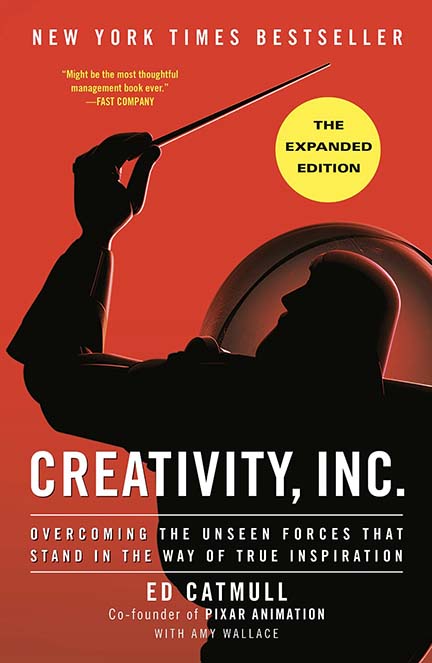Key Quote:
Unleashing creativity requires that we loosen the controls, accept risk, trust our colleagues, work to clear the path for them, and pay attention to anything that creates fear. Doing all these things won’t necessarily make the job of managing a creative culture easier. But ease isn’t the goal; excellence is” (p. 295). — Ed Catmull with Amy Wallace
Key Points and Concepts
Culture of Creativity
Teams thrive creatively when they contain various types and styles of thinkers who maintain their autonomy and individuality, while leaders give feedback and then step back to allow the team to take control (p. 19).
A sustainable creative culture has to promise and then actually deliver honesty, excellence, communication, originality, and self-assessment, no matter the consequences and personal difficulties.
Building and sustaining this in a practical and obtainable way is a full-time job for any leader (p. 65).
Creativity does not suddenly burst forth as a mature, fully-grown idea. It develops through a lengthy struggle, not unlike a marathon, that requires endurance, dedication, and a willingness to create the future (p. 223).
Trust in people, not the process. Teach your teams to take ownership of their own ideas and goals and use the processes as a framework to achieve the intended results (p. 79).
Without candor, creativity flounders in its own ignorance. Creative teams must put mechanisms in place to value candor over politeness and honest reactions over carefully crafted responses (p. 86).
Candid feedback is a rare and precious find in today’s world. At Pixar, ‘good notes’ need to address what is unclear, what is lacking, and what is bad. Good notes are extremely specific, given at a time when problems can be addressed, and usually don’t need to include a solution (p. 103).
Embracing mistakes requires viewing failure as an essential component to learning. But this phrase can easily become a cliché and not a reality within a creative culture because no one enjoys their flaws. More than just accepting failure with grace and moving forward as quickly as possible, Catmull regards failure as a manifestation of learning and exploration. If your people fear failure, they will consciously or unconsciously avoid risk and fall back on the comfortable and the safe. Work becomes derivative, not innovative, unless you teach your organization to embrace the reality of the pain of failure and the benefits of the resulting growth. Like the principles of scientific discovery, creativity needs to view any outcome involving trial and error as a positive because there are lessons in the successes and the failures of any idea (p. 109, 111, 114).
Don’t fall into the trap of believing ‘if you are successful, you are doing something right’ and ‘if you fail, you have done something wrong’ (p. 216).
Do not allow the need for additional product and revenue to drive the output; instead, focus on the strength of your ideas that are capable of creating something new (p. 136). Uncertainty is not the enemy of creativity. In fact, the unexplored can contain a fountain of inspiration and innovation (p. 158).
Avoid the urge to tighten controls and restrict your people in the face of uncertainty. Change may bring unforeseen challenges, but don’t allow yourself to see it as a threat. Recognize that change is crucial because the clash produces clarity for everyone involved (p. 152).
Don’t treat big difficulties and small difficulties individually with separate processes of resolving them. By disconnecting our reactions, we can easily ignore the seemingly smaller problems with larger, yet unseen, consequences. Use the same set of values, emotions, and procedures to solve and address all the unanticipated challenges, which allows you to retain a calmer perspective and allows your employees the ability to own and address their own mistakes (p. 160, 163).
While it’s difficult to recognize personal rigidity, teach your people that when they are inflexible and defensive in their viewpoints it is a dangerous leap toward shutting down alternative perspectives
(p. 192).
“Unleashing creativity requires that we loosen the controls, accept risk, trust our colleagues, work to clear the path for them, and pay attention to anything that creates fear. Doing all these things won’t necessarily make the job of managing a creative culture easier. But ease isn’t the goal; excellence is” (p. 295).
The Hidden
Leaders cannot lead without consistently spending time and energy to understand the nature of what is hidden (p. 169). This doesn’t mean having a singular focus on problems only, but rather devoting time to uncovering the hidden issues that are undoubtedly still thriving right under your nose (p. 237).
Difficulties and obstacles are interwoven into the daily processes and practices in any company, often in plain sight. While it sounds simple, the quest to identify what works and what doesn’t must be proactive and persistent, even during the good times (p. 6).
Hidden barriers to creativity are illusive because, even after challenges are seen, the human brain tends to attribute patterns and causes to events in an effort to understand the past. These patterns and sequences can continue to hide the unseen issues as meaning is assigned retroactively (p. 160).
Also, do not trust hindsight as your ‘20-20 vision’ since our past experiences can distort our view of the future (p. 177).
Our mental models create meaning and inferencesfrom shards of information without our conscious permission. The human brain tends to ignore information that conflicts with our predetermined viewpoints, leaving only information that agrees with what we think. This ‘confirmation bias’ and other unconscious trends ensure our conclusions are plagued by errors (p. 181).Catmull recommends candor, safety, research, self-assessment, and protecting the new as techniques to acknowledge the presence of the hidden and confront the challenges from the existence of the unknown (p. 185).
On the limitations of data, Catmull believes you should “measure what you can, evaluate what you measure, and appreciate that you cannot measure the vast majority of what you do” (p. 219).
The benefits and successes of a company often hide its flaws, and people are fearful of pointing out weaknesses because the good outweighs the bad. However, these issues then fester and eventually tunnel their way to explode on the surface. Therefore, Catmull built his new sense of purpose around the idea that “being on the lookout for problems is not the same as seeing problems” (p. 63).
The Braintrust
Pixar created a group of individuals with a knack for storytelling and a firm commitment to candor to screen and review movies while in production. This ‘Braintrust’ became a backbone for creating quality films because they identify, not just the problems, but also – more importantly – the sources of issues they see through constructive and specific critiques. However, it is not the goal of the group to solve anything, only to bring the challenges clearly to the director’s attention for him to solve with his team (p. 89, 93)
The Braintrust is necessary because anyone who engages in complex, creative projects will inevitably get lost at some point in the journey, no matter how talented or successful they have been in the past (p. 91).
The success of the Braintrust relies on the director being open to hearing the feedback without becoming defensive or offended. Catmull believes this can only happen when everyone realizes that ‘you are not your idea’ and when all power dynamics are completely removed from the setting and conversation (p. 94). Only then can directors believe in the power of the Braintrust to help them get where they need to go.
Outsiders observing the Braintrust meetings sometimes believe they’ve witnessed an argument because of the raised voices and spirited debate, but Catmull believes this kind of energy and enthusiasm reveal the depth of caring and investment everyone has in the finished product. After all, the debate is not about proving who is right or which point of view is dominant, but rather to uncover the truth (p. 99).
Leadership
Always hire people who are smarter than you. Ignoring your own insecurities and taking chances will yield the highest reward, as those under you will succeed, grow your company, and make you look better (p. 23).
It’s not enough to have good ideas. You must be successful at engaging and inspiring those who will be responsible for implementing your plans (p. 31).
Borrowing from Deming’s academic research and the example of Toyota’s manufacturing line, Catmull gives responsibility and ownership to every team member at Pixar. He wants every employee to strive for continual improvement of the process and have the ability to suggest changes, point to mistakes, address inefficiencies, and feel the satisfaction of their involvement in the final product (p. 50). This is possible when employees understand that quality remains the ultimate goal with efficiency being a tool used to create and sustain the quality of the product. People only believe this when it is backed up by leadership’s actions and decisions (p. 76).
Following the derailment and subsequent salvation of the development of Toy Story 2, Catmull learned that the formation of an excellent team always overshadows the quality of an idea. Give a great team a mediocre idea, and they can turn it into excellence. A mediocre team with a great idea does not mean the final product will be effective. Following this principle, the development department of Pixar is charged with finding great people instead of promising scripts. Great people will find, develop, and own successful ideas (p. 74).
If there is more candor in the hallways and behind closed doors than in the rooms where decisions are made, your organization has created a culture that is destined to fail. Leaders fight against this natural trend by identifying people who are willing to engage in straightforward, blunt conversations and keeping them close (p. 105).
Management’s main task is not to avoid mistakes and prevent potential risk, but to create and encourage the ability to recover from them.
Leaders need to view themselves as teachers and encourage an environment where teaching is viewed as a valuable contribution to the future of the organization (p. 123).
Authentic leaders do not default to secrecy automatically. If you do, you communicate that you don’t trust your employees and engender fear of the unknown instead of confidence in your leadership and direction (p. 125).
Teach your employees to see conflict as healthy and constructive and a tool used to balance competing desires and ideas. Managers must continually look for areas where balance has been lost and conflict no longer exists (p. 139).
The higher your position, the harder it is to get a complete picture of your organization, as people begin to only present their best selves around you. As you are increasingly successful, the full picture becomes progressively illusive. Don’t believe the fallacy that you can uncover and understand everything with enough work. Instead, recognize that “different viewpoints are additive rather than competitive” which can make your ideas more effective as they are honed and tempered by discussion (p. 173).
Catmull, E. and Wallace, A. (2014). Creativity, Inc.: Overcoming the Unseen Forces That Stand in the Way of True Inspiration. New York: Random House LLC.

Creativity does not suddenly burst forth as a mature, fully-grown idea. It develops through a lengthy struggle, not unlike a marathon, that requires endurance, dedication, and a willingness to create the future.
Always hire people who are smarter than you. Ignoring your own insecurities and taking chances will yield the highest reward, as those under you will succeed, grow your company, and make you look better.
If there is more candor in the hallways and behind closed doors than in the rooms where decisions are made, your organization has created a culture that is destined to fail. Leaders fight against this natural trend by identifying people who are willing to engage in straightforward, blunt conversations and keeping them close.
